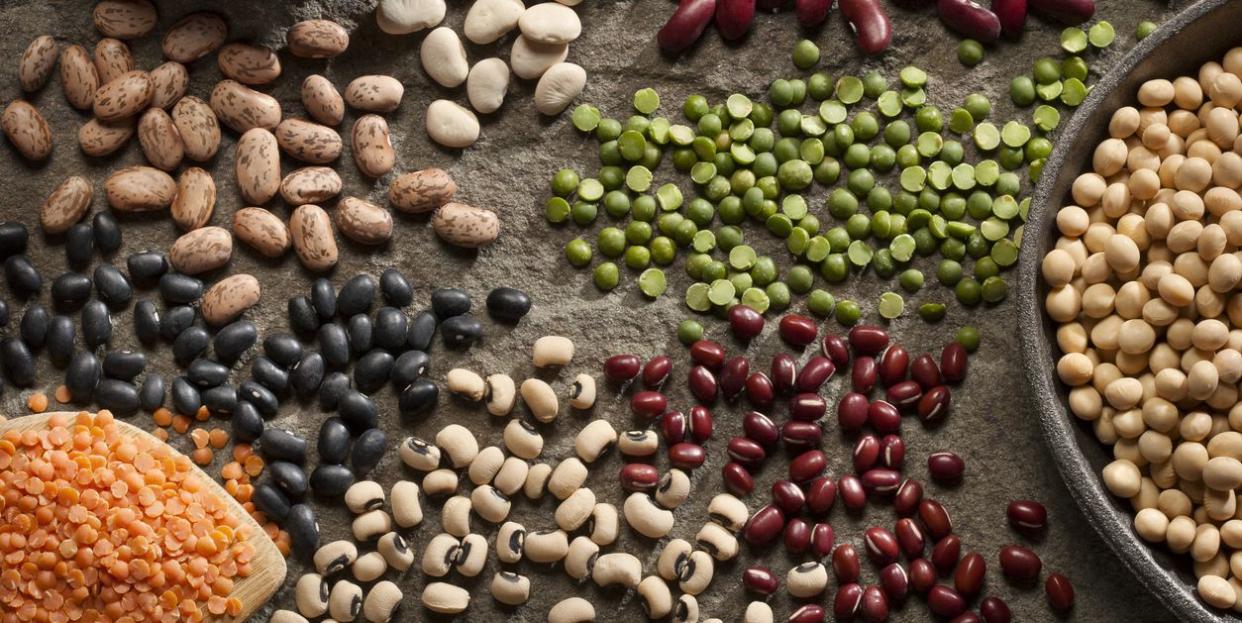The Lectin-Free Diet Claims Beans and Grains Are Bad for You—but Is It Legit?

Move over, gluten. There’s a new something that could be the cause of all of your wellness woes: Lectins.
Lectins are a naturally occurring protein found in beans, legumes, whole grains, and some vegetables. Lectins recently hit the big time after Steven Gundry, MD, a cardiac surgeon, singled them out in his book The Plant Paradox. In the book, he says that lectins are dangerous because they increase inflammation, and cause digestive woes and chronic diseases. Oh, and they can make you fat. Yikes.
That’s prompted a lot of people to cut out foods high in lectins from their diet (including Kelly Clarkson, who says she lost 37 pounds without exercising after reading The Plant Paradox). But is it really worth it-and are there any downsides you should know about? Here’s what you need to know about following a lectin-free diet.
What are lectins?
Lectins are a class of plant proteins that bind to certain sugars. Lectins may be a defense mechanism for plans to keep insects and animals from eating them. They're sometimes called "antinutrients," including by Dr. Gundry, because they interfere with nutrient absorption and digestion.
Foods high in lectins
Beans and legumes, including soy and peanuts
Whole grains
Nightshade vegetables like tomatoes, eggplant, potatoes, and peppers
Cow’s milk and eggs (because dairy cows and commercial chickens are fed lectin-containing grains like wheat and corn)
Are lectins bad for you?
Lectins are thought by some to act as an inflammatory toxin. “One of the claims is that they incite ‘biological warfare’ in the body to cause weight gain, digestive problems, acne, arthritis, and brain fog,” explains Christine Palumbo, RD, a registered dietitian and Nominating Committee member for the Academy of Nutrition and Dietetics.
Those are some pretty hefty allegations, and they’re not totally false. Red kidney beans in particular contain a type of lectin called phytohaemagglutinin. It can be toxic even in small amounts-but only if you were to eat the beans raw, which you’d probably never even consider doing. Cooking them deactivates the lectin and renders it harmless, according to the FDA. (The one exception is dried kidney beans cooked in a slow cooker, where the temperature isn’t high enough to deactivate the lectin.)
Some studies have also found that certain lectins can cause damage to the digestive tract. But most experts agree that the findings aren’t really applicable to humans. “They’ve looked at purified, isolated lectins, not lectins in the context of food. And they’ve been done in test tubes or on animals,” explains Megan Meyer, PhD, director of scientific communication at the International Food Information Council Foundation. “I haven’t seen anything with human studies, or even in clinically relevant situations that look at lectins in the diet.”
How to follow a lectin-free diet
If you're worried about how lectin-containing foods are affecting your health, then you can reduce the lectins in your diet by steering clear of processed or packaged foods that contain them. Sometimes they’re obvious-like a jar of tomato sauce or canned black bean soup. But sometimes they’re sneaky: There might be a soy-based thickener in your store-bought salad dressing or a corn-based sweetener in your breakfast cereal, for instance.
Dr. Gundry realizes it's hard to eliminate lectin-containing foods altogether, so he recommends soaking beans and grains before cooking them to help reduce the amount of lectins. He also says that pressure cooking, peeling and deseeding, and fermenting can help.
What to eat on a lectin-free diet
The FDA says that cooking the beans deactivates the lectin and renders it harmless. (The one exception is dried kidney beans cooked in a slow cooker, where the temperature isn’t high enough to deactivate the lectin.) Based on British studies, the FDA also advises soaking beans in water for at least five hours, drain the beans, and boil them in fresh water for at least 30 minutes.
That said, there are plenty of lectin-free foods to enjoy. Check out this complete lectin-free food list, which includes:
Avocados
Broccoli and other cruciferous vegetables like cauliflower and Brussels sprouts
Olive oil
Leafy greens such as spinach, kale and Romaine lettuce
Herbs such as parsley, mint, basil, and cilantro
Are there risks of a lectin-free diet?
Well, no, a lectin-free diet probably won’t hurt you. But it probably won’t do you any good, either, say Palumbo and Meyer. Not only would it be really difficult-there’s no good evidence showing that you might benefit. “These fearmongers who want to sell books, they’re charlatans,” Palumbo says. “They’re looking for that little something that they can inflate into a dramatic claim. It’s taking a little bit of correct information, but it’s not the whole story.”
What’s more, there’s a good chance that you’d miss out on some important nutrients. Whole grains, beans, and vegetables are rich sources of fiber, which is universally recognized as important for maintaining a healthy weight, lowering the risk for heart disease, and promoting healthy blood sugar levels. “So the research points to the converse, Meyer says. “These foods help us, they don’t hurt.”
The one exception? If you struggle with digestive problems and haven’t found relief by eliminating other foods (like gluten or FODMAPs), there’s no harm in seeing whether getting rid of lectins might help, Palumbo says. Just make sure to work with a registered dietitian, preferably one who specializes in digestive issues. They can oversee your diet to ensure that you’re eliminating foods in right way and that you’ll still get all the nutrition you need.
('You Might Also Like',)

